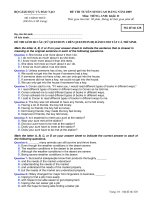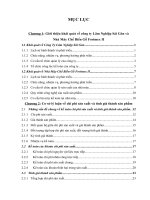TDC-Sensor 428
Bạn đang xem bản rút gọn của tài liệu. Xem và tải ngay bản đầy đủ của tài liệu tại đây (732.07 KB, 49 trang )
(1*,1(,167580(17$7,21
$9//,67*0%+
+DQV/LVW3ODW]
$*UD]$XVWULD
7HO
)D[
KWWSZZZDYOFRP
,GHQWQXPEHU $7(
5HYLVLRQQXPEHU
(GLWLRQ -DQXDU\
61BBBBBBBBBBBBBBBBBBBBB
6XEMHFWWRDOWHUQDWLRQ
3ULQWHGLQ$XVWULDE\
$9//,67*0%+*UD]
2SHUDWLQJ,QVWUXFWLRQV
7'&6HQVRU
Copyright 2002 AVL List GmbH, all rights reserved
The contents of this document may not be reproduced in any form or communicated to any third
party without the prior written consent of AVL.
While every effort is made to ensure is correctness, AVL assumes no responsibility for errors or
omissions which may occur in this document.
This manual contains important warning and safety instructions to be
observed by the user. This product is only intended for one certain area of
application which is described in the instructions. Furthermore the most
important necessary prerequisites for application and operation as well as
the safety measures are explained to ensure smooth operation.No warranty
or liability will be granted if the product is applied in areas others than those
described or if the necessary prerequisites and safety measures are not met.
The product is to be operated and used only by qualified personnel capable
of observing the required safety measures.
Only accessories and supplies either delivered by AVL or approved by AVL
are to be used with the product.
Due to the operating principle of this product the accuracy of measurement
results which it produces do not only depend upon its correct operation and
function, but also upon a variety of boundary conditions beyond the control
of the manufacturer. Therefore the results obtained from this product must
be subjected to careful examination by an expert (e.g. for plausibility) before
action based upon the results is undertaken.
Adjustment and maintenance of instruments when open and under voltage
are only to be carried out by a professional technician being aware of the
dangers involved. Protect instruments powered by the mains from humidity.
Repairs on the product are to be carried out by the manufacturer or qualified
service personnel only.
Upon application of the product an expert is to ensure that neither the object
of examination nor the testing equipment are operated under conditions that
my lead to damage or injury.
List GmbH
Important Notice! Important Notice
Important Notice! Important Notice
Safety Instructions
Any connected equipment that uses higher voltages than 50 V AC or
75 V DC must satisfy the requirements of the 73/23/EEC Directive.
Only shielded cables may be used with appropriately shielded connectors
in order comply with the 89/336/EEC Electromagnetic Compatibility
Directive.
Mains connections with standardised connectors and the exceptions
mentioned do not need to be shielded.
This device must not be used in any environment where there is a danger
of explosion.
The device must not be exposed to rain or permanent humidity or
moisture.
The device may only be opened by qualified personnel.
If a foreign body or liquid gets inside the device, disconnect it from the
mains and have an expert check it before using it again.
Make sure that the device is supplied with the correct supply voltage.
The device must not be connected to a direct voltage power supply
network.
Use the appropriate power supply unit.
TDC-Sensor Content
Operating Instructions I
1 Operating Instructions in Brief 1
1.1 General...................................................................................................................................................1
1.2 Measurement Principle........................................................................................................................1
1.3 Design ....................................................................................................................................................1
1.4 Procedure Determining TDC..............................................................................................................2
2 Application Area 3
3 System Components 5
3.1 Scope of Supply ....................................................................................................................................5
3.1.1 TDC-Sensor 428 =TI0428A.01= 5
3.1.2 TDC-Sensor Set 428 =TI0428SETA.01= 5
3.2 Optional Accessories............................................................................................................................6
3.2.1 Sensor Probes 6
3.2.2 Adaptor for Standard-Probe 428.10 6
4 Sensor Design 9
4.1 Sensor Electronics with Connection Cables and Balancing Unit...................................................9
4.2 Probe with Clamping Set.....................................................................................................................9
4.3 Adaptors................................................................................................................................................9
5 Operation Principle 11
5.1 TDC-Sensor 428 ..................................................................................................................................11
6 Preparing the Measurement 13
6.1 Selection of Measurement Bore ........................................................................................................13
6.1.1 Installation Position - Measuring Position 13
6.1.2 Typical Installation 14
6.1.3 Adaptor Design 17
6.2 Installing the Sensor Probe................................................................................................................20
6.2.1 Gap between Piston and Probe 20
6.2.2 Adjusting the TDC-Sensor Probe 21
6.3 Electrical Connections........................................................................................................................23
6.3.1 Connection Probe and Sensor Electronics 23
Content TDC-Sensor
Operating Instructions II
6.4 Electrical Balancing ........................................................................................................................... 24
6.4.1 Purpose of Balancing 24
6.4.2 Prerequisite 24
6.4.3 Balancing Unit 25
6.4.4 Checking the TDC Signal Amplitude 26
6.4.5 Checking the TDC Signal for Interference 26
7 Measurement Procedure 29
7.1 Cylinder in Non-fired Operation..................................................................................................... 29
7.2 Measurement with AVL Indicating Equipment............................................................................ 29
7.3 Typical Signal Curves ....................................................................................................................... 30
8 Errors and Remedies 31
8.1 Possible Damage................................................................................................................................ 31
8.2 Signal Influence at Gas Exchange.................................................................................................... 32
8.3 Typical Signal Signifying Touch with Piston................................................................................. 33
8.4 Sensor Probe Soiling.......................................................................................................................... 34
8.5 Sensor Probe Damage ....................................................................................................................... 34
8.6 Damage to the Sensor Probe Head.................................................................................................. 34
9 Technical Data and Dimensions 35
10 Appendix 39
10.1 CE Compliance................................................................................................................................... 39
10.2 List of Figures
..................................................................................................................................... 39
TDC-Sensor General Description
Operating Instructions 1
1 Operating Instructions in Brief
1.1
General
In the thermodynamic evaluation of pressure curves measured in internal combustion
engines, the exact determination of the top dead centre (TDC) position is of great
importance (e.g. in IMEP-measurements).
Since the rigid construction of internal combustion engines is not ideal, a statically
determined TDC can involve uncertainties.
1.2
Measurement Principle
The capacitive TDC-Sensor 428 is used to determine TDC dynamically in a motored IC
engine or partially firing IC engine (the cylinder to be measured is unfired and the others
are fired).
The 428 TDC sensor can be installed in most engines in existing indicating, injection or
spark plug bores.
The 428 TDC sensor evaluates the variation in capacitance between the piston and the
sensor probe head. Using SMD technology, a specially developed electronic circuit
delivers an analogue signal corresponding to the piston lift when it is near TDC.
The difference between TDC and trigger mark is calculated by determining the symmetry
angle of the compression lift signal.
1.3
Design
The TDC-Sensor 428 complete consists of the standard 260 mm sensor probe, the sensor
electronics which is directly mounted to the sensor probe with a 10 m connection cable
and a clamping set. For extra long sensor probe and mounting adaptors see Chapter
Optional Accessories, Page 6.
The sensor probe comprises a sensor element of the appropriate length and a sensor
probe head. The sensor probe can be adjusted easily by means of the clamping
mechanism. The sensor probe is installed in existing engine bores with a suitable adaptor.
The sensor electronic circuit is the same for all applications irrespective of sensor probe
length and installation position.
For analysing the TDC signal, the AVL Indicating Equipment Indimeter 619, Indiset 620,
Indiset Advanced 631, Indimaster 670, can be used in conjunction with a suitable Angle
Encoder (resolution 0.1 deg. crank angle, i.e. AVL 364/365 Angle Encoder).
General Description TDC-Sensor
2 Operating Instructions
1.4
Procedure Determining TDC
•
Mount a suitable adaptor in one of the existing bores in the cylinder head.
•
Insert the sensor probe into the adaptor and then adjust the distance between sensor
probe head and piston.
•
Fix the sensor electronics to the sensor probe
•
Connect the sensor electronics to an AVL Indicating Equipment or other evaluation
equipment.
•
Adjust TDC signal zero line (using potentiometer in the balancing unit, piston at
BDC).
•
Carry out the measurement.
TDC-Sensor General Description
Operating Instructions 3
2 Application Area
The AVL TDC-Sensor 428 is used to determine the precise position of TDC in dynamic operation. It
can also be applied for approximate static determination of TDC.
The TDC-Sensor 428 standard model with 260 mm sensor probe is designed to fit most IC engines
up to truck engine size. A 360 mm or 500 mm probe is available for larger engine sizes.
The prerequisites for dynamic TDC determination are suitable bores in the IC engine (indicating-,
spark plug- or injection bores) which can accommodate the sensor probe adaptors.
Measurement-related requirements for installation position are given in Chapter Selection of
Measurement Bore, Page 13.
Application Area TDC-Sensor
4 Operating Instructions
TDC-Sensor System Components
Operating Instructions 5
3 System Components
3.1
Scope of Supply
TDC-Sensor 428 =TI0428A.01=
The TDC Sensor 428 complete consists of the components listed below. These are
supplied as a complete order, but can, also be ordered separately as spare parts.
Sensor Electronics with connection cables and Balancing Unit 4028Z03 =BG 0297=
Sensor Probe, 260 mm long 428.10 =BO 0586=
Distributor 428 =EU 1726=
Clamping Set complete, comprising:
•
Adjustement Piece 428.30 =YF 0456=
Knurled Nut 428.31 =YF 0457=
•
Clamping Cone 428.20 =YF 0454=
Hexagonal Nut 428.21 =YF 0455=
•
Fixing Nut 428.40 =YF 0453=
•
Operating Manual 428 =AT0327E=
See Figure 9-1: Sensor Electronics 4028Z03, Figure 9-2: Sensor Probe 428.10 or 428.12,
428.14, Figure 9-3: Clamping Set complete.
3.1.2 TDC-Sensor Set 428 =TI0428SETA.01=
As a supplement to the indicating equipment there is a TDC-Sensor Set which contains
the recommended minimum parts required, namely.
•
TDC-Sensor 428 complete =TI0428A.01=
•
Extra Sensor Probe, 260 mm long 428.10 =BO 0586=
•
Adaptor M14x1.25 428.51 =YF 0486=
•
Adaptor M10x1 428.52 =YF0482=
•
Adaptor sleeve 428.53 =YF0483=
Application Area TDC-Sensor
6 Operating Instructions
3.2
Optional Accessories
3.2.1 Sensor Probes
Standard Probe 428.10 L = 260 mm
Probe for cylinder heads with deeper installations bores 428.12 L = 360 mm
Probe for cylinder heads with deeper installations bores 428.14 L = 5000 mm
/
Figure 3-1: Probe
3.2.2 Adaptor for Standard-Probe 428.10
The following adaptors are available for standard sensor probes L=260 mm) tobe
installed in AVL Pressure Transducer bores.
$
'
!
+
0
[
0
[
C@YÃ &
Figure 3-2: Adaptor 428.51 for spark plug bores with M14x1.25 thread
and indicating bores for pressure transducer with M14x1.25 thread
TDC-Sensor Systemkomponenten
Operating Instructions 7
$
$
'
Ã
#
Ã
%
'
H
#
C@YÃ &
H
Ã
%
C
'
Figure 3-3: Adaptor 428.52 for spark plug bores M10x1 thread
and indicating bores for pessure transducer with M10x1 thread
!'
Ã$
Ã
%
!
Ã
v
Ã
!
%
%
Ã
%
C
'
Ã
$
Figure 3-4: Adaptor Sleeve for Adaptor AH08 and 8ZP32
(for pressure transducer in 10 mm adaptor design)
Application Area TDC-Sensor
8 Operating Instructions
TDC-Sensor Sensor Design
Operating Instructions 9
4 Sensor Design
4.1
Sensor Electronics with Connection
Cables and Balancing Unit
The sensor electronics consists of a housing with permanent connector for the sensor
probe and a connection cable which is soldered to the pcb and fitted with a strain relief
cleat. The output signal cable with BNC plug is 2 m long, the power supply cable 5 m
long and has a 5-pin plug mounted. The balancing unit is included in the power supply
cable 2 meters behind the sensor electronics.
The 5-pin plug can be connected directly or via a relevant distributor with an AVL Angle
Encoder 365 (364) (see Chapter Connection Probe and Sensor Electronics, Page 23).
The BNC plug must be connected via a 10 m long connecting cable (e.g. E124-10) to
the data acquisition system.
As the cable capacity influences the accuracy of the measurement, it is not possible to
shorten or to extent the 10 m connecting cable.
Do not dismantle sensor electronics!
4.2
Probe with Clamping Set
The sensor probe consists of a sensor element and sensor probe head. The sensor
electronics connector is mounted to the sensor probe and fixed with the fixing nut. The
clamping set consists of a clamping cone with hexagonal nut, an adjustment piece with
knurled nut and a fixing nut. The sensor probe is fixed to the adaptor with the clamping
cone (M14x1 thread). The adjustment piece is used to adjust the gap between piston and
sensor probe head in defined increments (0 / 0.8 / 1.2 / 1.6 and 2.0 mm) in the direction
of the sensor axis.
4.3
Adaptors
The Sensor Probe is installed in an appropriate adaptor in an existing bore in the cylinder
head.
Regarding the large number of different types of engine and bore, it is not possible to
supply standard adaptors as accessories which will be suitable for any installation.
For non-standard installations, the user can quite easily manufacture an adaptor by
himself (examples of adaptor designs are given in Chapter Adaptor Design,
Page 17). Suitable standard adaptors are, of course, available as accessories for AVL
Precision Pressure Transducers (see Chapter Adaptor for Standard-Probe 428.10, Page 6).
Sensor Design TDC-Sensor
10 Operating Instructions
QrÃyÃphiyr
PÃvthyÃphiyr
BqÃyt
TrÃryrpvp
AvvtÃ
TrÃir
6qwrÃvrprÃpurq
hqÃxyrqÃ
8yhvtÃprÃvu
H # Ãurhq
hqÃurhthyÃ
6qhÃvhy
7I8ÃQyt
$vÃQyt
7hyhpvtÃv
"Ã
9vviÃ#!'
ÃÃÃÃ2@V &!%2
!v
ÃQyt
$v
Tpxr
!vÃTpxr
!Ã
!Ã
Figure 4-1: TDC-Sensor 428 - Assembly
TDC-Sensor Operation Principle
Operating Instructions 11
5 Operation Principle
5.1
TDC-Sensor 428
The sensor probe is fixed in the adaptor by the clamping cone. The adjustment piece is
then to define the gap between piston and sensor probe head (see Figure 5-1: TDC-
Sensor 428 Page 11). The sensor probe head and the piston are a capacitor. The
capacitance depends on the distance between both parts. Variations in capacitance are
detected by a capacitive bridge circuit. In Figure 5-2: Principal circuit diagram Page 11,
C2 represents the capacitor formed by the sensor probe head and the piston.
Square-wave pulses are applied to a capacitive bridge from an oscillator via circuit
elements which are dependent on the output voltage. If the capacitance varies, there is a
change in the potential divider ratio in the sequential of capacitors (Cl + C2 or C3 + C4).
This results in a change in the bridge quadrature component of voltage, which causes a
change in the output voltage from the differential amplifier and a shift in potential (el
and e2). This shift matches the amplitude of the pulses applied via the circuit elements
to the new capacitance conditions.
9rsvrq
qvhpr
TrÃir
Qv
Thqhq
hpvt
Figure 5-1: TDC-Sensor 428
Ppvyyh
ÃÃÃÃÃQrvhy
ÃÃÃÃqrrqr
pvpvÃryrr
9vssrrvhy
ÃÃ6yvsvr
PÃÃÃÃÃÃÃÃÃÃÃÃPÃ
8hhvvr
ÃÃÃivqtr
8
8"
8!
8#
QrvhyÃr
QrvhyÃr!
Figure 5-2: Principal circuit diagram
Operation Principle TDC-Sensor
12 Operating Instructions
TDC-Sensor Preparations for Measurement
Operating Instructions 13
6 Preparing the Measurement
6.1
Selection of Measurement Bore
To install a sensor probe for dynamic determination of TDC, there must be a suitable
bore in the cylinder head (indicating bore, spark plug bore or bore for injection nozzle
holder), to that an adaptor can be mounted to accommodate the sensor probe.
The measurement bore must meet the following criteria.
6.1.1 Installation Position - Measuring Position
The measurement bore chosen should ideally be as close as possible to the free end of
the crank shaft, i.e. close to the angle encoder. If the TDC sensor is installed at the
flywheel side and the angle encoder at the free end, crank shaft torsion will have to be
taken into consideration.
•
The bore axis should not be inclined more than 30 degrees from the piston axis.
•
The measuring position (sensor probe head - piston) should be at the piston surface
perpendicular to the piston lift direction.
•
If this is not possible (e.g. piston bowl), it must be endeavoured that as it
approaches TDC, the piston moves constantly closer to the sensor probe head. It
must be avoided, that due to the geometry of the piston bowl, the smallest distance
between sensor probe head and piston, i.e. the strongest signal, is reached before
the TDC.
•
If the sensor probe head points towards an inclined piston bowl wall or the cone of
a „Mexican hat“ piston the transverse piston motion can lead to measurement
errors.
•
For high precision measurements, in order to reduce measurement error due to
tipping of the piston, ensure that the measuring position at the piston lies in the
same plane of symmetry as the axis of the piston pin.
Preparations for Measurement TDC-Sensor
14 Operating Instructions
6.1.2 Typical Installation
h
Ã
$
h
Ã
"
&
%
6HQVRUHOHFWURQLFV
)L[LQJQXW
6HQVRUSUREH
$GMXVWPHQWSLHFH
&ODPSLQJFRQH
7LJKWHQLQJWRUTXH
+H[DJRQDOQXWPD[1P
+H[DJRQDOVFUHZWR1P
$GDSWRUVOHHYH
$GDSWRU$+
*DVNHW6*
Figure 6-1: Sensor probe in Adaptor AH08 (8ZP32)
TDC-Sensor Preparations for Measurement
Operating Instructions 15
h
Ã
$
G
r
t
u
Ã
Ã
G
h
Ã
"
%
T
h
q
h
q
Ã
h
p
v
t
Bhxr
hÃhÃhxÃyt
TrÃryrpvp
AvvtÃ
TrÃir
6qwrÃvrpr
8yhvtÃpr
UvturvtÃr)
CrhthyÃÃhÃ$ÃI
CrhthyÃprÃÃ ÃÃÃÃ $ÃI
6qhà $ÃI
6qh
Figure 6-2: Sensor probe in spark plug bore
Preparations for Measurement TDC-Sensor
16 Operating Instructions
6
W
D
Q
G
D
U
G
V
S
D
F
L
Q
J
6HQVRUHOHWURQLFV
)L[LQJQXW
&ODPSLQJFRQH
7LJKWHQLQJWRUTXH
+H[DJRQDOQXWPD[1P
+H[DJRQDOVFUHZWR1P
$GDSWRU
VDPHVKDSHDVIRUQR]]OHKROGHU
P
D
[
/
H
Q
J
W
K
Figure 6-3: Sensor probe in place of injectior









